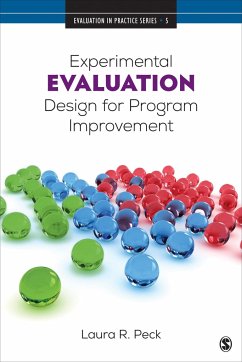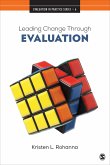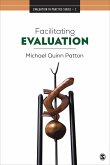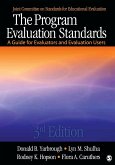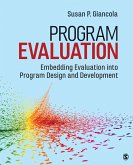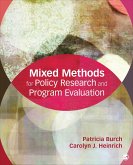Laura R. Peck
Experimental Evaluation Design for Program Improvement
Laura R. Peck
Experimental Evaluation Design for Program Improvement
- Broschiertes Buch
- Merkliste
- Auf die Merkliste
- Bewerten Bewerten
- Teilen
- Produkt teilen
- Produkterinnerung
- Produkterinnerung
This book, from SAGE's Evaluation in Practice series, considers variants of experimental evaluation designs, including those that are not commonly used but could be with much greater frequency. It also includes instructions for how to set up such experiments within program processes to learn about the effects of improvement efforts.
Andere Kunden interessierten sich auch für
![Leading Change Through Evaluation Leading Change Through Evaluation]() Kristen L. RohannaLeading Change Through Evaluation45,99 €
Kristen L. RohannaLeading Change Through Evaluation45,99 €![Facilitating Evaluation Facilitating Evaluation]() Michael Quinn PattonFacilitating Evaluation45,99 €
Michael Quinn PattonFacilitating Evaluation45,99 €![Culturally Responsive Approaches to Evaluation Culturally Responsive Approaches to Evaluation]() jill ChouinardCulturally Responsive Approaches to Evaluation45,99 €
jill ChouinardCulturally Responsive Approaches to Evaluation45,99 €![The Program Evaluation Standards The Program Evaluation Standards]() Donald B. YarbroughThe Program Evaluation Standards95,99 €
Donald B. YarbroughThe Program Evaluation Standards95,99 €![Program Evaluation Program Evaluation]() Susan P. GiancolaProgram Evaluation135,99 €
Susan P. GiancolaProgram Evaluation135,99 €![Mixed Methods for Policy Research and Program Evaluation Mixed Methods for Policy Research and Program Evaluation]() Patricia E. BurchMixed Methods for Policy Research and Program Evaluation101,99 €
Patricia E. BurchMixed Methods for Policy Research and Program Evaluation101,99 €![Generalized Linear Models for Bounded and Limited Quantitative Variables Generalized Linear Models for Bounded and Limited Quantitative Variables]() Michael SmithsonGeneralized Linear Models for Bounded and Limited Quantitative Variables45,99 €
Michael SmithsonGeneralized Linear Models for Bounded and Limited Quantitative Variables45,99 €-
-
-
This book, from SAGE's Evaluation in Practice series, considers variants of experimental evaluation designs, including those that are not commonly used but could be with much greater frequency. It also includes instructions for how to set up such experiments within program processes to learn about the effects of improvement efforts.
Hinweis: Dieser Artikel kann nur an eine deutsche Lieferadresse ausgeliefert werden.
Hinweis: Dieser Artikel kann nur an eine deutsche Lieferadresse ausgeliefert werden.
Produktdetails
- Produktdetails
- Evaluation in Practice Series
- Verlag: SAGE Publications Inc
- Seitenzahl: 104
- Erscheinungstermin: 1. Januar 2020
- Englisch
- Abmessung: 151mm x 228mm x 8mm
- Gewicht: 172g
- ISBN-13: 9781506390055
- ISBN-10: 1506390056
- Artikelnr.: 56791240
- Evaluation in Practice Series
- Verlag: SAGE Publications Inc
- Seitenzahl: 104
- Erscheinungstermin: 1. Januar 2020
- Englisch
- Abmessung: 151mm x 228mm x 8mm
- Gewicht: 172g
- ISBN-13: 9781506390055
- ISBN-10: 1506390056
- Artikelnr.: 56791240
Laura R. Peck, Ph.D., is a principal scientist at Abt Associates and has spent her career evaluating social welfare and employment policies and programs, both in research and academic settings. A policy analyst by training, Dr. Peck specializes in innovative ways to estimate program impacts in experimental and quasi-experimental evaluations, and she applies this to many social safety net programs. Dr. Peck is currently the principal investigator, co-PI, or director of analysis for several major national evaluations for the U.S. Departments of Health and Human Services, Labor, and Housing and Urban Development and over her career has been part of more than 35 informative evaluations of nonprofit, local, state, and federal programs and policies. Peck is a co-author of a public policy textbook and is well published on program evaluation topics. Prior to her work at Abt Associates, Dr. Peck was a tenured professor at the Arizona State University School of Public Affairs and also served as the founding associate dean of the Barrett Honors College, Downtown Phoenix campus. She earned her PhD from the Wagner Graduate School at New York University.
List of Boxes, Figures, and Tables Volume Editors' Introduction About the Author Acknowledgments Chapter 1
Introduction The State of the Field The Ethics of Experimentation What This Book Covers Questions and Exercises Resources for Additional Learning Chapter 2
Conceptual Framework: From Program Logic Model to Evaluation Logic Model Program Logic Model Evaluation Logic Model Conclusion Questions and Exercises Resources for Additional Learning Chapter 3
The Basic Experimental Design Defined Random Assignment Explained The Basic (Two-Armed) Experimental Design To Have a Control Group or Not to Have A Control Group? Questions and Exercises Resources for Additional Learning Chapter 4
Variants of the Experimental Design Multi-Armed Designs Factorial Designs Multistage Designs Staggered Introduction Designs Blended Designs Aligning Evaluation Design Options With Program Characteristics and Research Questions Conclusion Questions and Exercises Chapter 5
Practical Considerations and Conclusion Some Practical Considerations Road Testing Principles for Conducting High-Quality Evaluation Questions and Exercises Resources for Additional Learning Appendix
Doing the Math and Other Technical Considerations Estimating Treatment Impacts How to Interpret Results Handling Treatment Group No-Shows and Control Group Crossovers Subgroup Analyses Conclusion Questions and Exercises Resources for Additional Learning References Glossary Index
Introduction The State of the Field The Ethics of Experimentation What This Book Covers Questions and Exercises Resources for Additional Learning Chapter 2
Conceptual Framework: From Program Logic Model to Evaluation Logic Model Program Logic Model Evaluation Logic Model Conclusion Questions and Exercises Resources for Additional Learning Chapter 3
The Basic Experimental Design Defined Random Assignment Explained The Basic (Two-Armed) Experimental Design To Have a Control Group or Not to Have A Control Group? Questions and Exercises Resources for Additional Learning Chapter 4
Variants of the Experimental Design Multi-Armed Designs Factorial Designs Multistage Designs Staggered Introduction Designs Blended Designs Aligning Evaluation Design Options With Program Characteristics and Research Questions Conclusion Questions and Exercises Chapter 5
Practical Considerations and Conclusion Some Practical Considerations Road Testing Principles for Conducting High-Quality Evaluation Questions and Exercises Resources for Additional Learning Appendix
Doing the Math and Other Technical Considerations Estimating Treatment Impacts How to Interpret Results Handling Treatment Group No-Shows and Control Group Crossovers Subgroup Analyses Conclusion Questions and Exercises Resources for Additional Learning References Glossary Index
List of Boxes, Figures, and Tables Volume Editors' Introduction About the Author Acknowledgments Chapter 1
Introduction The State of the Field The Ethics of Experimentation What This Book Covers Questions and Exercises Resources for Additional Learning Chapter 2
Conceptual Framework: From Program Logic Model to Evaluation Logic Model Program Logic Model Evaluation Logic Model Conclusion Questions and Exercises Resources for Additional Learning Chapter 3
The Basic Experimental Design Defined Random Assignment Explained The Basic (Two-Armed) Experimental Design To Have a Control Group or Not to Have A Control Group? Questions and Exercises Resources for Additional Learning Chapter 4
Variants of the Experimental Design Multi-Armed Designs Factorial Designs Multistage Designs Staggered Introduction Designs Blended Designs Aligning Evaluation Design Options With Program Characteristics and Research Questions Conclusion Questions and Exercises Chapter 5
Practical Considerations and Conclusion Some Practical Considerations Road Testing Principles for Conducting High-Quality Evaluation Questions and Exercises Resources for Additional Learning Appendix
Doing the Math and Other Technical Considerations Estimating Treatment Impacts How to Interpret Results Handling Treatment Group No-Shows and Control Group Crossovers Subgroup Analyses Conclusion Questions and Exercises Resources for Additional Learning References Glossary Index
Introduction The State of the Field The Ethics of Experimentation What This Book Covers Questions and Exercises Resources for Additional Learning Chapter 2
Conceptual Framework: From Program Logic Model to Evaluation Logic Model Program Logic Model Evaluation Logic Model Conclusion Questions and Exercises Resources for Additional Learning Chapter 3
The Basic Experimental Design Defined Random Assignment Explained The Basic (Two-Armed) Experimental Design To Have a Control Group or Not to Have A Control Group? Questions and Exercises Resources for Additional Learning Chapter 4
Variants of the Experimental Design Multi-Armed Designs Factorial Designs Multistage Designs Staggered Introduction Designs Blended Designs Aligning Evaluation Design Options With Program Characteristics and Research Questions Conclusion Questions and Exercises Chapter 5
Practical Considerations and Conclusion Some Practical Considerations Road Testing Principles for Conducting High-Quality Evaluation Questions and Exercises Resources for Additional Learning Appendix
Doing the Math and Other Technical Considerations Estimating Treatment Impacts How to Interpret Results Handling Treatment Group No-Shows and Control Group Crossovers Subgroup Analyses Conclusion Questions and Exercises Resources for Additional Learning References Glossary Index
